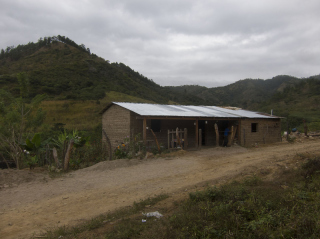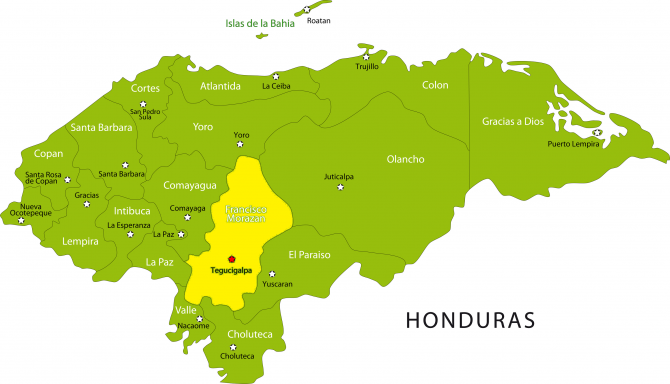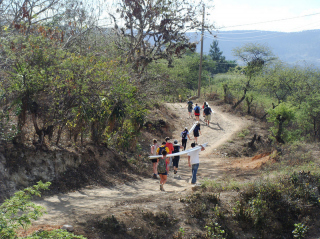Guaricayán, Honduras
![]()
![]()
![]()
![]()
![]()
![]()
![]() Click on Programs to learn more about their work in this community
Click on Programs to learn more about their work in this community
General Information
| Population* | 185 |
| Number of homes | 22 |
| Avg # of people per home | 8.4 |
| Number and % of children under 12 |
(0-5 years): 10.8% (0-9 years): 27.6% |
| Primary Occupations | Agriculture |
| Water System | Yes |
| Rural Bank | Yes |
| % of Houses with Latrines | 100% |
| Electricity | Yes |
| Corresponding Health Center and Distance | CESAR - Zarzal, 1 hour walking |
| Common Illnesses | Flu, cough |
| School Access and Distance | 1st-6th grade, in community |
| Municipality | San Juan de Flores |
| Department | Francisco Morazán |
| Distance from compounds | 1 hour |
* Population does not reflect how many patients will be seen on medical
brigades as many people from surrounding communities come seeking
Medical Brigades medical attention.
Top Three Needs Expressed
Guaricayán and Global Brigades are proud to say that through holistic programming, the top health and economic needs of the community have been covered. Guaricayán also has proven strong leadership and capitalized funds in their community bank in order to address any needs that arise in the future.


Guaricayan is located in a flat, dry valley. It is a very small community located near the town of Zarzal.
Guaricayan’s educational system includes a primary school (until 6th grade). There are 20 students, and Walberto Varela is the school director. He is also the only teacher at the school and has to teach all 6 grades at one time. Approximately 80% of the community knows how to read and write.
When Global Brigades first came to the community, Guaricayán had a water system that was constructed by the government in 1987 and was not functionig. Global Brigades improved the water system in 2011. Currently, 100% of homes are connected to the water system, and the water is regularly chlorinated. There is a Water Council with 5 active members, led by Lino Lopez. To find out more about the water system in Guaricayán, click the water logo at the top of the page.
Guaricayán does not have a health center in the community. The nearest health center is in Zarzal, which is about 1.5-hours away by foot, and is staffed by nurse Oralita Benitez. Dental care is not available in the community or at the health center.
Global Brigades and Oralita selected Guaricayán as one of the communities in which to implement GB’s Community Health Workers (Guardianes de Salud) program. There is one community health worker, Georgina Espinal, who acts as a CHW in conjunction with Global Brigades for this community. You can learn more about the CHW program in Guaricayán by clicking the CHW logo at the top of the page.
The most common illnesses seen by community members are flu and cough. Global Brigades implemented a Public Health project in this community in 2012. Almost 100% of houses have concrete floors, latrines, eco-stoves, showers and pilas (water storage units). To learn more about the Public Health projects in Guaricayán, you can click the PH program logo at the top of the page.
The average family income per month is estimated to be 2400 Lempiras, which is an approximate average of L480 (US $25.41) per person. The majority of homes are made of adobe. The main form of employment is agriculture on owned land, and the main crops are corn and beans. Global Brigades started a community bank in Guaricayán in 2012 in conjunction with the Public Health program. The bank offers many financial services such as savings accounts, financial counseling and loans. Currently, several microbusinesses have started in the community thanks to Global Brigades and Business Brigades. The community members hope to keep working and to create more financial opportunities in their community in the future. To learn more about business and microfinance in Guaricayán, click the program logos at the top of the page.
Global Brigades is currently in the process of constructing a community bank building within Guaricayán. The project is expected to be complete by December 2015.
 |
 |
Source of information: Key informant interview, Centro de Salud statistics
Date of interview: 27 April 2010
1The accepted regulation frequency for chlorinating water is every 4 days.
2CESAMO and CESAR are terms used for types of health centers. CESAMOs are larger, more comprehensive facilities that usually have a physician on staff at all times and occasionally a dentist. CESARs are more remote, less equipped facilities, usually with
1-2 nurses on staff.
3According to Red Solidaria and World Food Programme in Honduras, the average family is approximated at 5 people per household, the poverty line is L930 (US$49.23) per person per month, and the extreme poverty line is L617 (US$32.66) per person per month.